Gias Uddin
Stack Trace-Based Crash Deduplication with Transformer Adaptation
Aug 26, 2025Abstract:Automated crash reporting systems generate large volumes of duplicate reports, overwhelming issue-tracking systems and increasing developer workload. Traditional stack trace-based deduplication methods, relying on string similarity, rule-based heuristics, or deep learning (DL) models, often fail to capture the contextual and structural relationships within stack traces. We propose dedupT, a transformer-based approach that models stack traces holistically rather than as isolated frames. dedupT first adapts a pretrained language model (PLM) to stack traces, then uses its embeddings to train a fully-connected network (FCN) to rank duplicate crashes effectively. Extensive experiments on real-world datasets show that dedupT outperforms existing DL and traditional methods (e.g., sequence alignment and information retrieval techniques) in both duplicate ranking and unique crash detection, significantly reducing manual triage effort. On four public datasets, dedupT improves Mean Reciprocal Rank (MRR) often by over 15% compared to the best DL baseline and up to 9% over traditional methods while achieving higher Receiver Operating Characteristic Area Under the Curve (ROC-AUC) in detecting unique crash reports. Our work advances the integration of modern natural language processing (NLP) techniques into software engineering, providing an effective solution for stack trace-based crash deduplication.
TriagerX: Dual Transformers for Bug Triaging Tasks with Content and Interaction Based Rankings
Aug 23, 2025Abstract:Pretrained Language Models or PLMs are transformer-based architectures that can be used in bug triaging tasks. PLMs can better capture token semantics than traditional Machine Learning (ML) models that rely on statistical features (e.g., TF-IDF, bag of words). However, PLMs may still attend to less relevant tokens in a bug report, which can impact their effectiveness. In addition, the model can be sub-optimal with its recommendations when the interaction history of developers around similar bugs is not taken into account. We designed TriagerX to address these limitations. First, to assess token semantics more reliably, we leverage a dual-transformer architecture. Unlike current state-of-the-art (SOTA) baselines that employ a single transformer architecture, TriagerX collects recommendations from two transformers with each offering recommendations via its last three layers. This setup generates a robust content-based ranking of candidate developers. TriagerX then refines this ranking by employing a novel interaction-based ranking methodology, which considers developers' historical interactions with similar fixed bugs. Across five datasets, TriagerX surpasses all nine transformer-based methods, including SOTA baselines, often improving Top-1 and Top-3 developer recommendation accuracy by over 10%. We worked with our large industry partner to successfully deploy TriagerX in their development environment. The partner required both developer and component recommendations, with components acting as proxies for team assignments-particularly useful in cases of developer turnover or team changes. We trained TriagerX on the partner's dataset for both tasks, and it outperformed SOTA baselines by up to 10% for component recommendations and 54% for developer recommendations.
Hallucination Detection in Large Language Models with Metamorphic Relations
Feb 20, 2025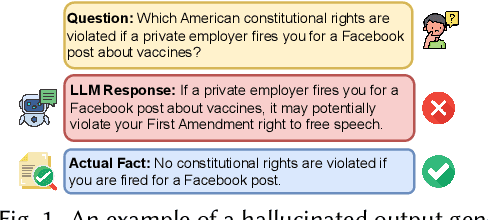
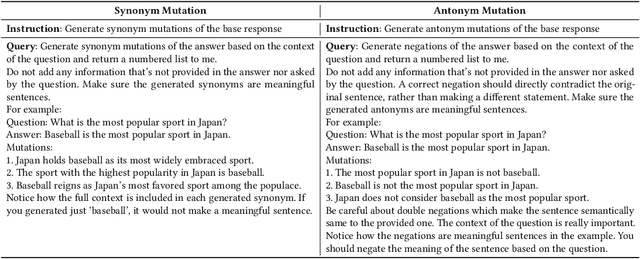
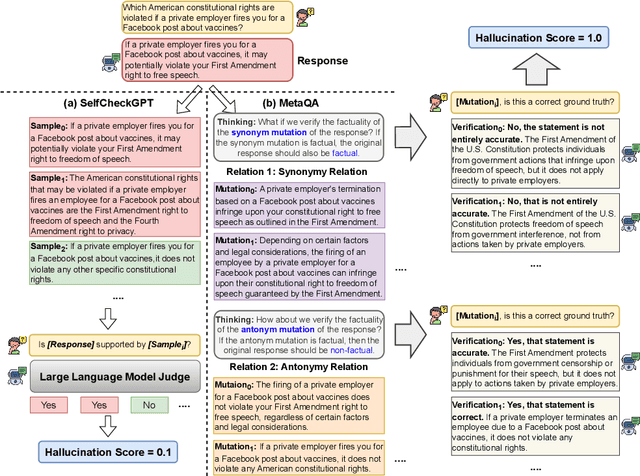
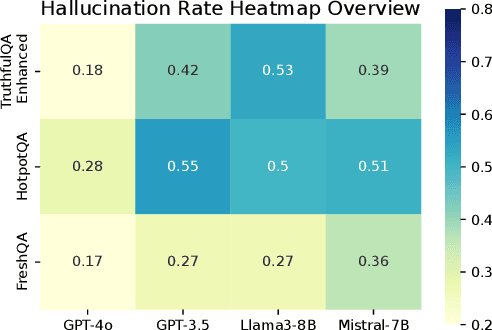
Abstract:Large Language Models (LLMs) are prone to hallucinations, e.g., factually incorrect information, in their responses. These hallucinations present challenges for LLM-based applications that demand high factual accuracy. Existing hallucination detection methods primarily depend on external resources, which can suffer from issues such as low availability, incomplete coverage, privacy concerns, high latency, low reliability, and poor scalability. There are also methods depending on output probabilities, which are often inaccessible for closed-source LLMs like GPT models. This paper presents MetaQA, a self-contained hallucination detection approach that leverages metamorphic relation and prompt mutation. Unlike existing methods, MetaQA operates without any external resources and is compatible with both open-source and closed-source LLMs. MetaQA is based on the hypothesis that if an LLM's response is a hallucination, the designed metamorphic relations will be violated. We compare MetaQA with the state-of-the-art zero-resource hallucination detection method, SelfCheckGPT, across multiple datasets, and on two open-source and two closed-source LLMs. Our results reveal that MetaQA outperforms SelfCheckGPT in terms of precision, recall, and f1 score. For the four LLMs we study, MetaQA outperforms SelfCheckGPT with a superiority margin ranging from 0.041 - 0.113 (for precision), 0.143 - 0.430 (for recall), and 0.154 - 0.368 (for F1-score). For instance, with Mistral-7B, MetaQA achieves an average F1-score of 0.435, compared to SelfCheckGPT's F1-score of 0.205, representing an improvement rate of 112.2%. MetaQA also demonstrates superiority across all different categories of questions.
VLDBench: Vision Language Models Disinformation Detection Benchmark
Feb 17, 2025



Abstract:The rapid rise of AI-generated content has made detecting disinformation increasingly challenging. In particular, multimodal disinformation, i.e., online posts-articles that contain images and texts with fabricated information are specially designed to deceive. While existing AI safety benchmarks primarily address bias and toxicity, multimodal disinformation detection remains largely underexplored. To address this challenge, we present the Vision-Language Disinformation Detection Benchmark VLDBench, the first comprehensive benchmark for detecting disinformation across both unimodal (text-only) and multimodal (text and image) content, comprising 31,000} news article-image pairs, spanning 13 distinct categories, for robust evaluation. VLDBench features a rigorous semi-automated data curation pipeline, with 22 domain experts dedicating 300 plus hours} to annotation, achieving a strong inter-annotator agreement (Cohen kappa = 0.78). We extensively evaluate state-of-the-art Large Language Models (LLMs) and Vision-Language Models (VLMs), demonstrating that integrating textual and visual cues in multimodal news posts improves disinformation detection accuracy by 5 - 35 % compared to unimodal models. Developed in alignment with AI governance frameworks such as the EU AI Act, NIST guidelines, and the MIT AI Risk Repository 2024, VLDBench is expected to become a benchmark for detecting disinformation in online multi-modal contents. Our code and data will be publicly available.
Perceived Confidence Scoring for Data Annotation with Zero-Shot LLMs
Feb 11, 2025



Abstract:Zero-shot LLMs are now also used for textual classification tasks, e.g., sentiment/emotion detection of a given input as a sentence/article. However, their performance can be suboptimal in such data annotation tasks. We introduce a novel technique Perceived Confidence Scoring (PCS) that evaluates LLM's confidence for its classification of an input by leveraging Metamorphic Relations (MRs). The MRs generate semantically equivalent yet textually mutated versions of the input. Following the principles of Metamorphic Testing (MT), the mutated versions are expected to have annotation labels similar to the input. By analyzing the consistency of LLM responses across these variations, PCS computes a confidence score based on the frequency of predicted labels. PCS can be used both for single LLM and multiple LLM settings (e.g., majority voting). We introduce an algorithm Perceived Differential Evolution (PDE) that determines the optimal weights assigned to the MRs and the LLMs for a classification task. Empirical evaluation shows PCS significantly improves zero-shot accuracy for Llama-3-8B-Instruct (4.96%) and Mistral-7B-Instruct-v0.3 (10.52%), with Gemma-2-9b-it showing a 9.39% gain. When combining all three models, PCS significantly outperforms majority voting by 7.75%.
ChatGPT Incorrectness Detection in Software Reviews
Mar 25, 2024Abstract:We conducted a survey of 135 software engineering (SE) practitioners to understand how they use Generative AI-based chatbots like ChatGPT for SE tasks. We find that they want to use ChatGPT for SE tasks like software library selection but often worry about the truthfulness of ChatGPT responses. We developed a suite of techniques and a tool called CID (ChatGPT Incorrectness Detector) to automatically test and detect the incorrectness in ChatGPT responses. CID is based on the iterative prompting to ChatGPT by asking it contextually similar but textually divergent questions (using an approach that utilizes metamorphic relationships in texts). The underlying principle in CID is that for a given question, a response that is different from other responses (across multiple incarnations of the question) is likely an incorrect response. In a benchmark study of library selection, we show that CID can detect incorrect responses from ChatGPT with an F1-score of 0.74 - 0.75.
Contrastive Learning for API Aspect Analysis
Aug 14, 2023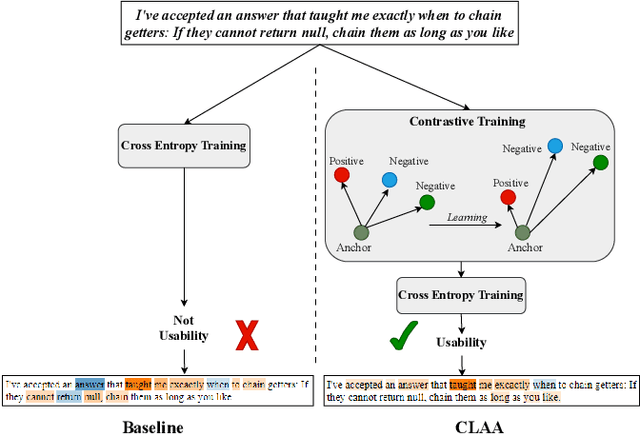



Abstract:We present a novel approach - CLAA - for API aspect detection in API reviews that utilizes transformer models trained with a supervised contrastive loss objective function. We evaluate CLAA using performance and impact analysis. For performance analysis, we utilized a benchmark dataset on developer discussions collected from Stack Overflow and compare the results to those obtained using state-of-the-art transformer models. Our experiments show that contrastive learning can significantly improve the performance of transformer models in detecting aspects such as Performance, Security, Usability, and Documentation. For impact analysis, we performed empirical and developer study. On a randomly selected and manually labeled 200 online reviews, CLAA achieved 92% accuracy while the SOTA baseline achieved 81.5%. According to our developer study involving 10 participants, the use of 'Stack Overflow + CLAA' resulted in increased accuracy and confidence during API selection. Replication package: https://github.com/disa-lab/Contrastive-Learning-API-Aspect-ASE2023
An Empirical Study of IoT Security Aspects at Sentence-Level in Developer Textual Discussions
Jun 07, 2022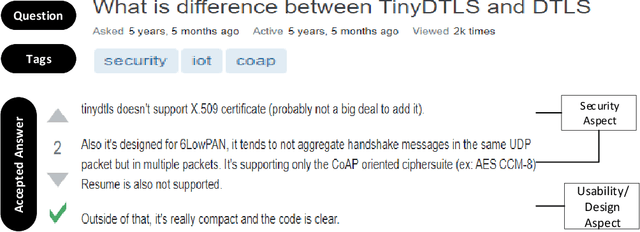

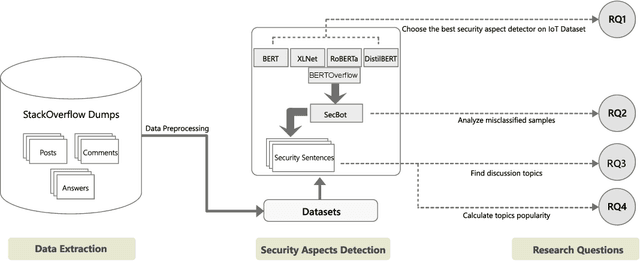
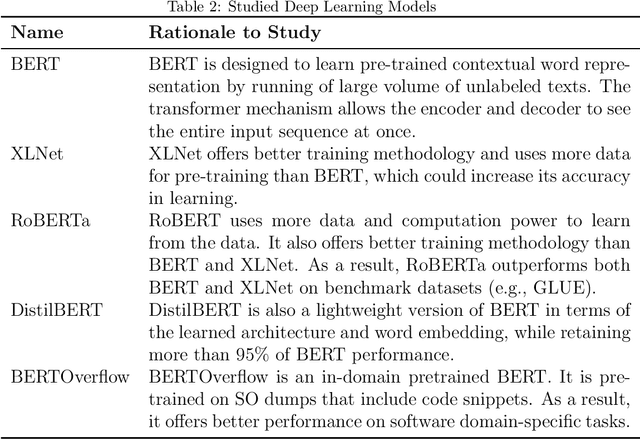
Abstract:IoT is a rapidly emerging paradigm that now encompasses almost every aspect of our modern life. As such, ensuring the security of IoT devices is crucial. IoT devices can differ from traditional computing, thereby the design and implementation of proper security measures can be challenging in IoT devices. We observed that IoT developers discuss their security-related challenges in developer forums like Stack Overflow(SO). However, we find that IoT security discussions can also be buried inside non-security discussions in SO. In this paper, we aim to understand the challenges IoT developers face while applying security practices and techniques to IoT devices. We have two goals: (1) Develop a model that can automatically find security-related IoT discussions in SO, and (2) Study the model output to learn about IoT developer security-related challenges. First, we download 53K posts from SO that contain discussions about IoT. Second, we manually labeled 5,919 sentences from 53K posts as 1 or 0. Third, we use this benchmark to investigate a suite of deep learning transformer models. The best performing model is called SecBot. Fourth, we apply SecBot on the entire posts and find around 30K security related sentences. Fifth, we apply topic modeling to the security-related sentences. Then we label and categorize the topics. Sixth, we analyze the evolution of the topics in SO. We found that (1) SecBot is based on the retraining of the deep learning model RoBERTa. SecBot offers the best F1-Score of 0.935, (2) there are six error categories in misclassified samples by SecBot. SecBot was mostly wrong when the keywords/contexts were ambiguous (e.g., gateway can be a security gateway or a simple gateway), (3) there are 9 security topics grouped into three categories: Software, Hardware, and Network, and (4) the highest number of topics belongs to software security, followed by network security.
Are You Misinformed? A Study of Covid-Related Fake News in Bengali on Facebook
Mar 22, 2022



Abstract:Our opinions and views of life can be shaped by how we perceive the opinions of others on social media like Facebook. This dependence has increased during COVID-19 periods when we have fewer means to connect with others. However, fake news related to COVID-19 has become a significant problem on Facebook. Bengali is the seventh most spoken language worldwide, yet we are aware of no previous research that studied the prevalence of COVID-19 related fake news in Bengali on Facebook. In this paper, we develop machine learning models to detect fake news in Bengali automatically. The best performing model is BERT, with an F1-score of 0.97. We apply BERT on all Facebook Bengali posts related to COVID-19. We find 10 topics in the COVID-19 Bengali fake news grouped into three categories: System (e.g., medical system), belief (e.g., religious rituals), and social (e.g., scientific awareness).
An Empirical Study of the Effectiveness of an Ensemble of Stand-alone Sentiment Detection Tools for Software Engineering Datasets
Nov 04, 2021



Abstract:Sentiment analysis in software engineering (SE) has shown promise to analyze and support diverse development activities. We report the results of an empirical study that we conducted to determine the feasibility of developing an ensemble engine by combining the polarity labels of stand-alone SE-specific sentiment detectors. Our study has two phases. In the first phase, we pick five SE-specific sentiment detection tools from two recently published papers by Lin et al. [31, 32], who first reported negative results with standalone sentiment detectors and then proposed an improved SE-specific sentiment detector, POME [31]. We report the study results on 17,581 units (sentences/documents) coming from six currently available sentiment benchmarks for SE. We find that the existing tools can be complementary to each other in 85-95% of the cases, i.e., one is wrong, but another is right. However, a majority voting-based ensemble of those tools fails to improve the accuracy of sentiment detection. We develop Sentisead, a supervised tool by combining the polarity labels and bag of words as features. Sentisead improves the performance (F1-score) of the individual tools by 4% (over Senti4SD [5]) - 100% (over POME [31]). In a second phase, we compare and improve Sentisead infrastructure using Pre-trained Transformer Models (PTMs). We find that a Sentisead infrastructure with RoBERTa as the ensemble of the five stand-alone rule-based and shallow learning SE-specific tools from Lin et al. [31, 32] offers the best F1-score of 0.805 across the six datasets, while a stand-alone RoBERTa shows an F1-score of 0.801.
 Add to Chrome
Add to Chrome Add to Firefox
Add to Firefox Add to Edge
Add to Edge